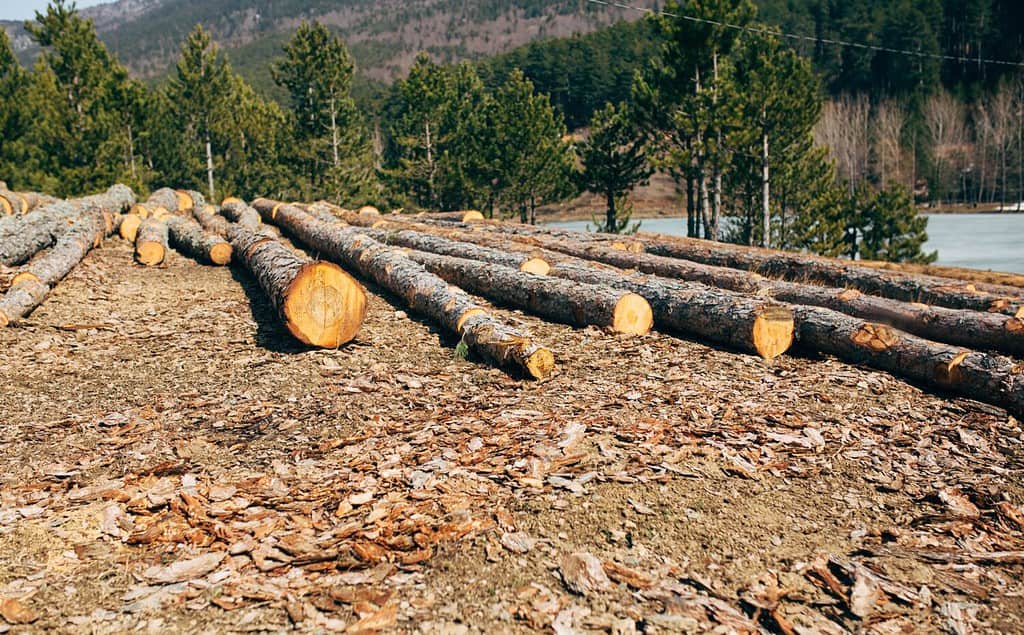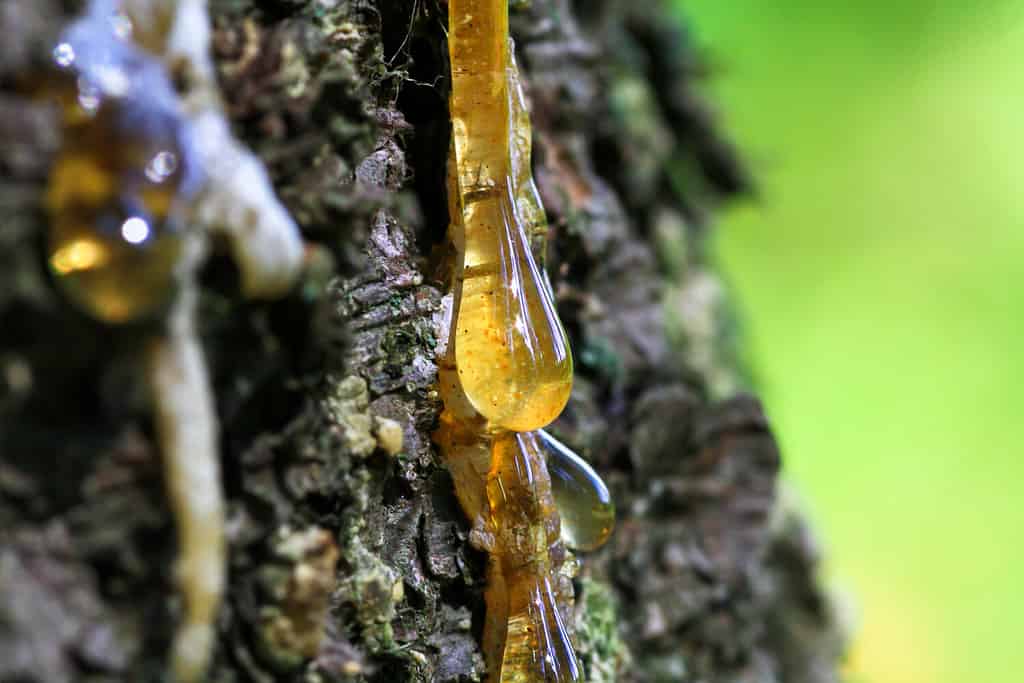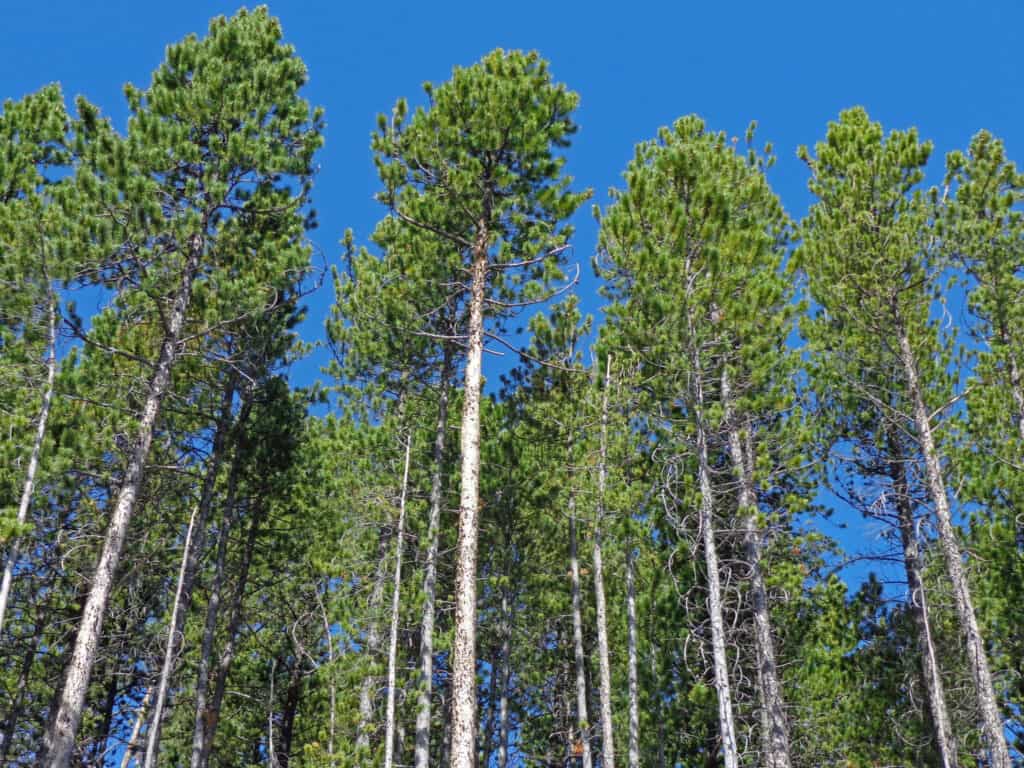Pine trees are one of the most commercially important species of tree in the world. They are milled for lumber and paper products, turpentine, various resins, and wood oils. Some species even produce edible seeds. They’re also popular landscaping choices. Fast-growing, fragrant, and evergreen, they provide a quick windbreak or privacy screen around property borders. They can grow in poor soil and their thick root systems can secure soil that is subject to erosion. They’re hardy and can survive in USDA Plant Hardiness zones 3a-9b (northern Maine to central Florida!) But before you run off to the nursery and start digging holes in your yard, consider some of the serious reasons experts say you might want to avoid planting a pine tree.

As a group of fast-growing species with long, straight trunks and soft, easily workable wood, pines are a commercially important species.
©Olenaduygu/Shutterstock.com
Popular Varieties of Pine Trees
Pine trees are coniferous evergreens of the genus Pinus. They have evergreen needles, reproduce with pine cones, and grow from 30-250 feet tall depending on the species. Various sources peg the number of species at anywhere from 115-220. Of these, 49 are native to North America. Although pines grow virtually all over the United States, Maine has claimed the title “Pine Tree State” because 89% of the state’s land area is forested with pine and other species. These are 10 of the most common types of pines you might encounter in the forest, on the farm, or in the front yard:
- Eastern White Pine
- Western White Pine
- Sugar Pine
- Red Pine
- Pitch Pine
- Jack Pine
- Longleaf Pine
- Shortleaf Pine
- Loblolly Pine
- Slash Pine
Reasons You Should Not Plant Pine Trees
Despite the year-round beauty, fast growth, hardiness, Christmasy fragrance, and other attractions of pine trees there are some very good reasons not to plant pine trees.
1. They Grow in Poor Soil . . . But It Has to Be a Special Kind of Poor Soil
Yes, all over the world there are VAST forests of them growing everywhere from lowland swamps to actually growing out of sheer cliffsides and cracks in giant boulders. Where do they even find any soil in such places? None of that matters in your yard though, because your new pine tree will get yellow needles and grow slowly unless the soil is acidic (with a pH below 7.0). And if your soil is heavy clay that doesn’t drain well, they won’t like that either. They also don’t appreciate air pollution. This means if you live in an urban or industrial area, or near a busy highway with a lot of car exhaust, they may start dying. It almost seems like they grow best in the forest . . . where we found them in the first place. Hmmmm.
2. They are Explosively Flammable

Pines as well as other evergreens can be a major fire hazard.
©iStock.com/bradscottphotos
Pine resin burns like a petroleum product. Pine firewood will burn even when it’s damp. If you throw a knotty pine branch into a fire it pops and can throw out sparks and embers. Pine needles and pinecones around the base of the tree are similarly combustible. However, the level of flammability varies with the weather conditions, species of tree, and age, affecting younger trees more than older ones. Regardless, you’re definitely better off without any of these near your house if you live in a wildfire-prone area.
3. Their Wind Resistance is Questionable
Research has shown that pine trees can remain standing even if wind gusts reach 50 miles per hour. But not always. Pine canopies are dense, which makes them good windbreaks in normal circumstances. In exceptionally strong winds, that same heavy canopy can act like a giant sail, toppling trees over or even snapping their trunks. Pines, like many other species, are especially susceptible to being uprooted by wind if the ground is waterlogged from heavy rains.
4. They Rain Destruction on Your Yard House, and Car

Resin runs down the trunk and drips from the branches of pine trees. You’ll basically have damaging sticky glue on anything under them: your roof, car, kids, and dogs.
©yanikap/Shutterstock.com
Pine trees drop an enormous amount of dead needles, pinecones, and branches around their base, on parked cars, and on the roof of your house if they overhang it. These materials are not only flammable but acidic and slow to decompose. They will kill all the grass and any other plantings around them except species that can adapt to a pine forest environment. They can clog your car’s vents, your house’s gutters, your leaf vacuum, and your lawnmower.
Pines also drip thick, sticky, glue-like resin on everything under them. If you don’t get it off right away, it will harden and chip your paint when you try to pick it off later. And if you get it on your clothes or skin, it’s difficult to wash off. You have to use isopropyl alcohol. Imagine your kids chase a ball into your pine forest and get it on their clothes. Or your dog chases a squirrel or plays with a pinecone and gets sticky resin in their fur, on your rugs, and on your couch. The possibilities for mischief are endless.
5. Some Species “Self-Prune” in Undesirable Ways

Many species of pine drop their lower branches as they grow, leaving behind bare trunks.
©Sara Kendall/Shutterstock.com
Fast-growing pines planted relatively close together can make an attractive evergreen privacy screen between you and your neighbors. Some species, though, are “self-pruning,” meaning that lower branches die and drop off the tree, leaving a bare trunk behind. This creates an awesome open effect in a pine forest with a quiet carpet of needles to muffle your footsteps mysteriously. And it’s great for loggers basically to have these enormous branch-free trunks that can be made into awesome construction lumber. But what about your beautiful privacy screen? Well, year by year it will be lifted up 20, 30, 40 feet into the sky, while you and your neighbors once again have an unobstructed look into one another’s yards.
6. They Are Prone to Pine Diseases
Pines have their very own special diseases. Needlecast is a fungal infection that must be treated with a fungicide to prevent it from killing the tree. Another example is pine wilt, a nematode infection carried by beetles that feed on pines. This one is incurable. You’ll have to cut the tree down and burn it to stop the disease from spreading to other trees.
Bonus: You Can Die From a Falling Pinecone

Believe it or not, some kinds of pines drop 11-pound pinecones!
©Brannon_Naito/Shutterstock.com
We couldn’t leave you without a “fun” bonus reason not to plant pine trees. Believe it or not, some people have died from a falling pinecone. One, single pinecone. Now, there are a few caveats. This would be a pinecone 20 inches long – the length of two basketballs, side by side, 6 inches wide, and weighing 11 pounds. And it has to be dropped from really high up, like from the top of a 250-foot pine tree, or one hanging off a mountain over a trail in a canyon below. But hey, the point is . . . it can happen! So homeowners, plant at your own risk, and maybe wear a hard hat!
The photo featured at the top of this post is © iStock.com/Clark Ahlstrom
Thank you for reading! Have some feedback for us? Contact the AZ Animals editorial team.







